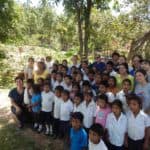Brown University built and operates the clinic at Guachipilincito, the small community about an hour’s walk or an hour’s drive from Concepcion. That sounds strange to say to those of us that are accustomed to cars driving along well paved roads, or distances that can be measured by a straight line extended from point A to point B. These assumptions don’t apply to Guachi, a place very close and yet so far away.
Brown has been coming down for many years. They are physically present in a brigade two times a year, but their presence there is more constant then that. There are various programs and supports that they have invested in for the people of Guachi that connect them to the wider world. But it’s very hard to maintain. Maybe it’s like building a sand castle along the shore during low tide. That’s not to say it’s a fool’s errand, but just that as close as one gets to Guachi, it seems to stay far away. But Brown has built buildings and relationships, is committed to ongoing service, makes the journey regularly, and something, though elusively hard to define, remains.
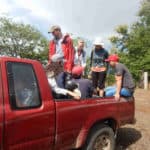
I was looking forward to meeting the nine person brigade, Brown University now partnered with Wingate University, School of Pharmacy. Wayne Hale, a man of great talent and knowledge, is always asking penetrating questions because he readily recognizes the inadequacy of his talent and knowledge. I was looking forward to the stimulating conversation, the discernment of strategy and service, but the necessary response to unanticipated challenges kept Brown/Wingate, Wayne, and Guachi distant. Two of their brigade members, one a medical student and the other a resident, found themselves even further away from Guachi as they did not make it onto the planes flying from the US to Honduras. I went to Tegucigalpa on the next day to escort them into the Frontera; six hours in for me and eight hours back for them. They got there a day late, but that is not so surprising when you think of the almost insurmountable chasm of distance between Miami or Atlanta and Guachi. I never got to Guachi during their week here. Another brigade in Camasca, the presence of a board member and the need to translate, innovative and exciting improvements at our bilingual school, and a series of other demands made that distance to Guachi even further. Thank God there’s two of us, because Laura did get there.
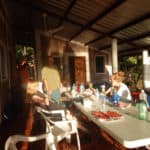
She went to Guachi with two Honduran, Shoulder to Shoulder doctors, one from our main clinic in Concepción and the other from the town clinic. She arranged for them to sit down and dialogue with Wayne, Judy Steinberg (the board president for the Guachi mission), and with other brigade members. They spoke about our Convenio system of care. They spoke about how to make referrals. They spoke about how to collaborate in mission. They spoke about the health and well-being needs of the people in Guachi. They spoke about how Brown/Wingate could help in ongoing care and how Shoulder to Shoulder’s presence and work in the Frontera could help bring effectiveness to the mission in Guachi. In a word, they spoke about how to bridge distances.
That is the main focus of our work here. It would be so easy if there weren’t so many mountains. It would be so easy if we had good roads. It would be so easy if Honduras weren’t so poor, or if the Honduran government would actually fund health care. It would be so easy if there weren’t so many cultural divides, or if we all spoke the same language. It would be so easy if Guachipilincito wasn’t that place that seems so close, but is really a world away. So, you build bridges. This is tremendously difficult work. It takes more than goodwill, talent, and knowledge. It takes an investment in humility and vulnerability, a patience that understands that the seemingly short distance is actually very far.
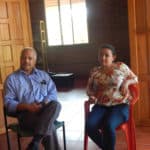
I didn’t get to Guachi. On the day that they were leaving, they hiked into Concepción. A truck would transport their luggage to their bus. The bus can’t get to Guachi because of the road. The bus would pick them up outside of our house in Concepción. I met them in the town square during market day: vegetable, fruits, venders, and pirated DVDs in every corner. They were all smiles, shaking my hand and introducing themselves. Their brigade was a great success. I was feeling some guilt that I had not gotten to them or to Guachi in the week that they were here. They, however, treated me as an old friend, and were excited to get to my house and see Laura again. At the house, they rehydrated after the arduous, hot, hour plus walk over mountain and dale. They had a few minutes to relax on our porch.
I spoke with Lynn, Wayne’s wife. I apologized for not getting to see them this week. We also talked about how sometimes it’s hard to know what’s best to do with limited resources and Guachi being so far away. She told me of a woman she met. The woman suffered with dwarfism and her feet were turned out perpendicular to her body. She walked with great difficulty. They had found some paper and traced the outline of her feet. With that they managed to buy shoes that fit her. She walks easier now. Lynn’s take on the whole thing (something she and her husband have been involved with all of their lives) was that you do what you can with what’s placed in front of you in the moment. What more can be expected? That was what she, and they, did for the woman she met. I thought about these great distances. This one woman was probably further away from the rest of the world than anyone in Guachi. Yet, she was found. She was met. She was honored. Maybe Guachipilincito is not as far away as it seems.
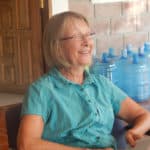
Thanks, Brown/Wingate Brigade, for making it to Guachipilincito.
Recording Hope
Jens sits at our dining room table, our only table, in La Esperanza, as Laura and I explain to him the particular water challenges we face here in Intibucá. Jens, a 17 year old, US born citizen of German heritage, living in Tegucigalpa, Honduras, is visiting with us over the next few days. His older brother Jan, Jan’s friend Aeden, and Mario, a friend of both families and the driver/chaperon for the trip, are all visiting us in our small and modest home. Aeden is home from college in Prague where he studies cinematography. Jan is interested in the same career, but studies at Emory University in Georgia. Shoulder to Shoulder has contracted with Aeden to produce three videos: two will be short ones on brigades and Shoulder to Shoulder in general, and the third will be a documentary on the bilingual school. Presently, we’re trying to arrange a fold out coach and three mattresses on our limited floor space so everyone can sleep. Jens continues to incredulously question us on the water, unwilling to conceive that water runs only every other day. “But, what do you do about that ‘take a shower every day’ rule?” We then introduce Jens to the concept of a bucket shower, a concept he’ll become familiar with over the next three days.
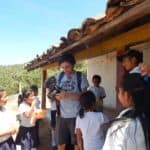
The rural, isolated, poor, frontier region of Intibucá is very unfamiliar to our four guests from Tegucigalpa. You might say that it presents as more foreign to them than it would have even to us when we first arrived. But they have all come with a spirit of openness, acceptance, and generosity. They capture on video the commitment to service in Pinares where Virginia Commonwealth University and Fairfax Family Practice Centers are holding their two week medical brigade. After a morning and afternoon of videotaping there, we drive south toward Concepcion where our guests will stay with us in our home there. It is clear that Mario doesn’t believe me when I tell him that three minutes after leaving Pinares we’ll run out of pavement. When we begin bumping up and down, navigating the trenches where rain has eroded the road, he asks how far to Concepcion. “Maybe ten miles, but it will take us about an hour.” Mario works with the Central American Bank. The Central American Bank subsidized the paving of this road. According to their records, it’s been paved all the way to Camasca. He will register an official complaint report. But our going is slow, not only because of the road, but also because every five minutes or so, Aeden and Jan yell to stop the car. They grab their equipment and jump out of the car. They take beautiful shots of the expansive terrain, the majestic mountains, and the awe it inspires. I take this road too often. I no longer recognize the breathtaking views or the bumpy drive.
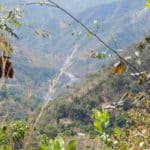
In Concepcion we all settle into our home. There is a lot more space and rooms, but we’re short a mattress. Mario disappears for a short time, and, unbeknownst to us, borrows a mattress from our neighbors. We tell the boys there is always water at night, but we often lose it for a few hours in the morning. They take no heed to our warning. In the morning, as they take their bucket showers, Laura and I are holding back our laughter as we watch them throwing cold water from our pila onto their bodies. So energetic and enthusiastic, so bright and ready to take on the world. With the medium of video, they will make art, their free expression to inspire.
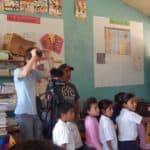
We head to Camasca and the bilingual school. Here, they are recording a view of hope. The parents send their children to our school with a great hope of something new, of achievement, of a better day. I can’t help think about those expansive, limitless views of the mountains from yesterday. Ironic, here where boundless beauty is so easily witnessed in nature, the constraints of poverty are so clear. Poverty limits experience, limits the horizon. Aeden films Juan Carlos and Keilyn, two cousins who live two-hundred meters below the town proper. They don’t have much, but they do have a climb up a great hill every morning. It’s a rugged climb and I feel some shame for my self pity that the road I travel is not paved. The path Juan Carlos and Keilyn take is one with carved footholds into a slate, rock face. They climb, we climb, we film, we record, and this is hope. It springs upon us when we reach the summit, an opening appears. Then we’re at the school.
Some of us have been given much, some of us, little. But all of us have rutted roads to travel, and all of us can gaze upon the expansive beauty of our world. Can not all of us then pattern hope? We can remember and record. We can share. It is not so important from where we start our journeys, but the integrity of the journey is the clear testament of hope.
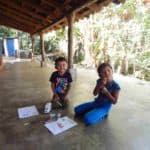
Pickups and Bubbles: An Elusive Measure
Let’s see. Twenty-three participants, eleven translators (four were leaving on that day, so there were four extra in the morning), two brigade coordinators, and two drivers, I think that is thirty eight. Okay so maybe it was thirty-seven or thirty nine, I didn’t actually count. The Virginia Commonwealth University / Fairfax Family Practice Center Brigade at Pinares, San Marcos de la Sierra, set out that Tuesday morning for two smaller communities: Cedros and Las Marias. So everyone packed into two pickup trucks. For the sake of argument, let’s just say nineteen in each pickup. Okay, so each pickup did have an extended cab. They probably squished seven into each cab. That meant that each pickup bed held about twelve persons, plus medications, supplies, and everybody’s lunch.
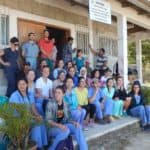
We followed behind them in our comfortable Toyota Land Cruiser. Comfortable perhaps, only by comparison, because we were six persons and a ton of gear. Shoulder to Shoulder had contracted with Aeden O’Connor, a twenty year old cinematography student from Tegucigalpa studying in Prague, to produce some video documentaries on our mission. They were a crew of four with Laura and I along as guides. We watched the pickups travel slowly in front of us, a partially comical, partially surreal scene. They traveled slowly, for safety as much as necessity, and we wondered about the incredible strain on those vehicles so weighted down. We traveled about two miles north, back toward La Esperanza, on the half gravel, half paved “highway,” before taking a left on the access road toward the two smaller communities. The one lane rock and gravel path twisted, rose, and fell along mountainous terrain. The road, literally carved out of the mountain ledge, meant a wall of rock to the right, and, to the left, the sheer two, three, or four hundred foot drop to the base of the mountain. We actually never got that far away from the main highway, it always remaining in sight less than a mile to the east. But, the rugged terrain and weighted vehicles could all but inch and crawl toward our destination. One truck continued straight on as we followed the other to the left and the community of Cedros. But we never really saw any community per se, a single house here and there along the road. Most of the inhabitants don’t live along the road, nor do they live in any community. Their houses are scattered and hidden under the pines, no electric lines running overhead, accessible by foot paths descending and ascending from the road. The entirety of the drive is a short distance, no more than four miles, but it takes about thirty minutes. We arrive at the end of the road at a school, sitting above a huge soccer field.
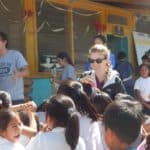
Down to the left of the school is a small church, and just beyond the soccer field, accessible by a footpath, a house. But there is nothing else here. We’re in the middle of a forest. Still, the children are waiting for us, forty or fifty of them. Where did they come from and how did they get here? VCU / FFPC is here for the CHI (Children’s Health Initiative) program. They will take heights and weights, check blood for anemia, check their eyesight, apply varnish to their teeth, and give a few other tests. They set up something of an assembly line to do this efficiently. But the kids are already involving themselves with the fair-skinned, English-speaking guests. Some are playing soccer and others are circling about Aeden, his film crew, and the camera. Two young women from the brigade take out bubble bottles and start blowing bubbles into the air. The kids gather around them, clapping at them and jumping up to try to catch them in their hands. A few of them attempt to blow the bubbles themselves, but they haven’t mastered the art. Most of them have probably never seen soap bubbles. Unless they were fortunate enough to go to a town fiesta in San Marcos, there would be no opportunity to buy them. Even so, very few of their families could afford such a luxury item. The kids are bright-eyed, joyous. Their laughter and their smiles, so inviting and uninhibited, transform this humble school yard into a magical fantasy world. The adults are smiling too, unconsciously, almost as if they are dreaming. I am happy to think that Aeden is getting it all on video.
Some will cynically question the worth of a brigade. Twenty three Americans from the medical and academic world, many of whom don’t speak any Spanish, all coming from a world far removed from the realities of Cedros, visit for two weeks. Will they have any lasting effect? Will they have any real impact on the enduring poverty? I suppose if the assessment of the value of such a trip is only to be judged by empirical metrics, the cynics will be justified. But bubbles, laughter, and smiles defy empirical measurement. The good that is achieved, both for the Hondurans as well as the brigade participants, is not a value of the head, but one of the heart.
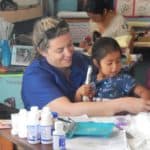 The small encounters will be remembered. Enrichment, empowerment, development, and meaningful growth are not so much a measure of what is given or taken, but rather found in the elusiveness of what is shared. VCU / FFPC came with two physical therapy doctoral students. Though I may be mistaken, and my apologies if I am, I cannot recall physical therapy being part of any other brigade. With the severity of muscular-skeletal, chronic conditions resulting from accidents and the abiding conditions of exhaustive, physical labor, how important is this discipline here in the Frontera. The two therapists saw an incredible amount of patients and offered them solutions and relief that they would not otherwise have discovered. Both of them related the story of one man. As they told the story, their faces beamed as they choked back tears. The man had suffered a stroke and was partially paralyzed. He walked only with great difficulty and effort. They created for him a sling to secure under his foot. With his arms he could hoist his lifeless leg and swing it forward. They practiced with him and soon the man had mastered the maneuver. His life had completely changed by this simple gift of their knowledge. He would no longer be confined and dependent. He would no longer feel himself a burden to his friends and family. He could walk under his own power. What a gift!
The small encounters will be remembered. Enrichment, empowerment, development, and meaningful growth are not so much a measure of what is given or taken, but rather found in the elusiveness of what is shared. VCU / FFPC came with two physical therapy doctoral students. Though I may be mistaken, and my apologies if I am, I cannot recall physical therapy being part of any other brigade. With the severity of muscular-skeletal, chronic conditions resulting from accidents and the abiding conditions of exhaustive, physical labor, how important is this discipline here in the Frontera. The two therapists saw an incredible amount of patients and offered them solutions and relief that they would not otherwise have discovered. Both of them related the story of one man. As they told the story, their faces beamed as they choked back tears. The man had suffered a stroke and was partially paralyzed. He walked only with great difficulty and effort. They created for him a sling to secure under his foot. With his arms he could hoist his lifeless leg and swing it forward. They practiced with him and soon the man had mastered the maneuver. His life had completely changed by this simple gift of their knowledge. He would no longer be confined and dependent. He would no longer feel himself a burden to his friends and family. He could walk under his own power. What a gift!
So light these bubbles in the air that drift above and beyond us, so seemingly insignificant. Yet it is this lightness that holds a world of magic, the wonder and mystery of all that is discovered in sharing.


